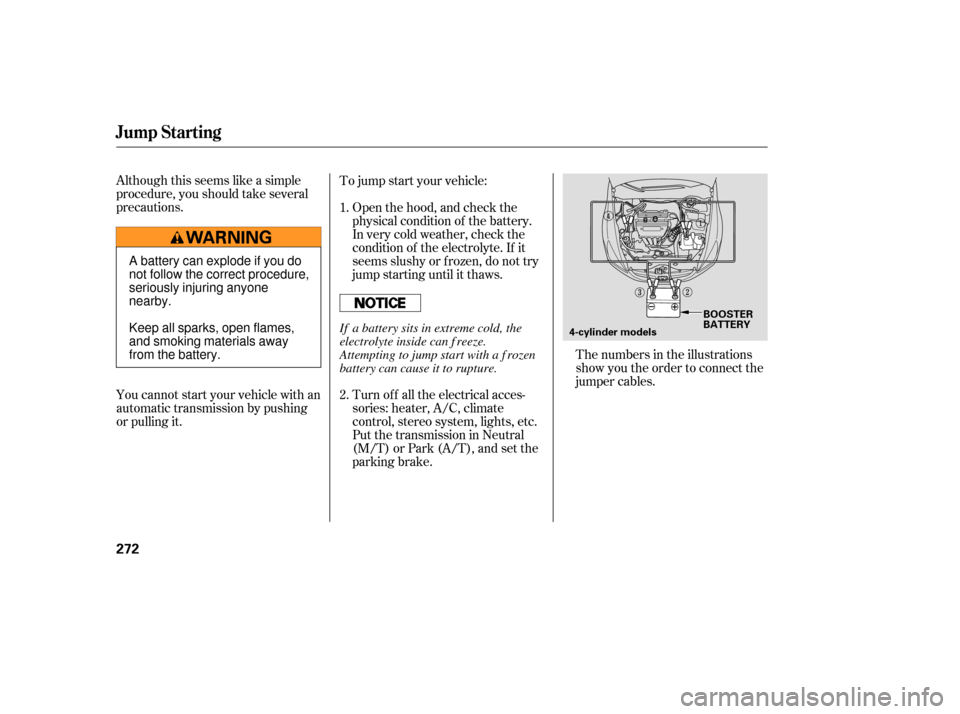Page 241 of 319
CONT INUED
4-cylinder models
Check the f luid level with the engine
at normal operating temperature.Park the vehicle on level ground.
Shut of f the engine.
Remove the dipstick (yellow loop)
f rom the transmission, and wipe it
with a clean cloth. Insert the dipstick all the way into
the transmission securely as
shown in the illustration.
Make sure the notch in the rubber
cap f its in the dipstick guide and
that you push the dipstick in all
the way.
1.
2. 3.
Automatic Transmission
Windshield Washers, T ransmission Fluid
Maint enance
239
6-cylinder models
LEVEL GAUGE
DIPSTICKDIPSTICK
GUIDE
UPPER MARK
LOWER MARK
Do not use engine antif reeze or a
vinegar/water solution in the
windshield washer reservoir. Antif reeze
can damage your vehicle’s paint, while
a vinegar/water solution can damage
the windshield washer pump. Use only
commercially-available windshield
washer f luid.
�����—�����—�����y�
�������������y���
�(���%�������y���������y
Page 242 of 319

Remove the dipstick and check
the f luid level. It should be
between the upper and lower
marks.
If the level is below the lower
mark, add f luid into the dipstick
hole to bring it to the upper mark.
Pour the f luid slowly and caref ully
so you do not spill any. Clean up
any spill immediately; it could
damage components in the engine
compartment.
Always use Honda ATF-Z1
(automatic transmission f luid). If
it’s not available, you may use a
DEXRON
III automatic
transmission f luid as a temporary
replacement. However, continued
use can affect the shift quality.
Have the transmission f lushed and
ref illed with Honda ATF-Z1 as
soon as it is convenient. Insert the dipstick all the way back
into the transmission securely as
shown in the illustration.
Make sure the notch fits in the
dipstick guide and the dipstick is
down all the way.
If you are not sure how to add f luid,
contact your dealer.
Check the f luid level with the engine
at normal operating temperature.Park the vehicle on level ground.
Shut of f the engine.
Remove the dipstick (yellow loop)
f rom the transmission, and wipe it
with a clean cloth.
5. 4. 6.
1.
2.
6-cylinder models
T ransmission Fluid
Automatic Transmission
240
DIPSTICK
�����—�����—�����y�
�������������y���
�(���%�������y���������y
Page 243 of 319

Insert the dipstick all the way back
into the transmission securely as
shown in the illustration.
Remove the dipstick and check
the f luid level. It should be
between the upper and lower
marks.
If the level is below the lower
mark, add f luid into the dipstick
hole to bring it to the upper mark.
Pour the f luid slowly and caref ully
so you do not spill any. Clean up
any spill immediately; it could
damage components in the engine
compartment.
Always use Honda ATF-Z1
(automatic transmission f luid). If
it’s not available, you may use a
DEXRON
III automatic
transmission f luid as a temporary
replacement. However, continued
use can af f ect the shif t quality.
Have the transmission f lushed and
ref illed with Honda ATF-Z1 as
soon as it is convenient. Make sure the notch fits in the
dipstick guide and the dipstick is
down all the way.
If you are not sure how to add f luid,
contact your dealer.
Insert the dipstick all the way into
the transmission securely as
shown in the illustration.
Make sure the notch in the rubber
cap f its in the dipstick guide and
that you push the dipstick in all
the way.
3. 4.
5.
6.
T ransmission Fluid
Maint enance
241
UPPER MARK
LOWER MARK
�����—�����—�����y�
�������������y���
�(���%�������y���������y
Page 264 of 319

To minimize sticking, apply a
silicone spray lubricant to all door
and trunk seals. Also, apply a
vehicle body wax to the painted
surfaces that mate with the door
and trunk seals.
Cover the vehicle with a
‘‘breathable’’ cover, one made
f rom a porous material such as
cotton. Non-porous materials, such
as plastic sheeting, trap moisture,
which can damage the paint.
Leave the parking brake off. Put
the transmission in reverse
(manual) or Park (automatic).
Block the rear wheels.
If the vehicle is to be stored f or a
longer period, it should be
supported on jackstands so the
tires are of f the ground.
Leave one window open slightly (if
the vehicle is being stored
indoors).
Disconnect the battery.
Support the f ront wiper blade
arms with a f olded towel or rag so
they do not touch the windshield.
If you need to park your vehicle f or
an extended period (more than 1
month), there are several things you
should do to prepare it f or storage.
Proper preparation helps prevent
deterioration and makes it easier to
get your vehicle back on the road. If
possible, store your vehicle indoors.
Fill the f uel tank.
Change the engine oil and f ilter.
Wash and dry the exterior
completely.
Cleantheinterior.Makesurethe
carpeting, floor mats, etc., are
completely dry. If possible, periodically run the
engine until it reaches f ull
operating temperature (the
cooling f an cycles on and of f
twice). Pref erably, do this once a
month.
Vehicle Storage
262
�����—�����—�����y�
�������������y���
�(���%�������y���������y
Page 272 of 319

Store the jack in its holder. Turn
the jack’s end bracket to lock it in
place. Replace the cover. Store the
tools.
Store the wheel cover or center
cap in the trunk. Make sure it does
not get scratched or damaged.
Lower the trunk floor, then close
the trunk lid. Di
agnosing why the engine won’t
start falls into two areas, depending
on what you hear when you turn the
ignition switch to the START (III)
position: Wh
en you turn the ignition switch to
the START (III) position, you do not
hear the normal noise of the engine
trying to start. You may hear a
clicking sound or series of clicks, or
nothing at all.
Check these things:
You
hear nothing, or almost
nothing. The engine’s starter
motor does not operate at all, or
operates very slowly.
You can hear the starter motor
operating normally, or the starter
motor sounds like it is spinning
faster than normal, but the engine
does not start up and run.
Turn the ignition switch to the ON
(II) position. Turn on the
headlights, and check their
brightness. If the headlights are
very dim or do not come on at all,
the battery is discharged. See on page .
Check the transmission interlock.
If you have a manual transmission,
the clutch pedal must be pushed
all the way to the f loor or the
starter will not operate. With an
automatic transmission, it must be
in Park or neutral.
20.
21. 22.
272
If the Engine Won’t Start
Nothing Happens or the Starter
Motor Operates Very Slowly
Jump Starting
Changing a Flat Tire, If the Engine Won’t Start
270
Loose items can fly around the
interior in a crash and could
seriously injure the occupants.
Store the wheel, jack, and tools
securely before driving.
�����—�����—�����y�
������
������y���
�(���%�������y���������y
Page 274 of 319

Although this seems like a simple
procedure, you should take several
precautions.
You cannot start your vehicle with an
automatic transmission by pushing
or pulling it.To jump start your vehicle:
The numbers in the illustrations
show you the order to connect the
jumper cables.
Turn of f all the electrical acces-
sories: heater, A/C, climate
control, stereo system, lights, etc.
Put the transmission in Neutral
(M/T) or Park (A/T), and set the
parking brake. Open the hood, and check the
physical condition of the battery.
In very cold weather, check the
condition of the electrolyte. If it
seems slushy or f rozen, do not try
jump starting until it thaws.
1.
2.
Jump Starting
272
4-cylinder models
BOOSTER
BATTERY
A battery can explode if you do
not follow the correct procedure,
seriously injuring anyone
nearby.
Keep all sparks, open flames,
and smoking materials away
from the battery. If a battery sits in extreme cold, the
electrolyte inside can f reeze.
Attempting to jump start with a f rozen
battery can cause it to rupture.
�����—�����—�����y�
������
������y���
�(���%�������y���������y
Page 287 of 319

�µ�µ
If your vehicle needs to be towed,
call a prof essional towing service or
organization. Never tow your vehicle
with just a rope or chain. It is very
dangerous.
If , due to damage, your vehicle must
be towed with the f ront wheels on
the ground, do this:
Release the parking brake.
Shif t the transmission to neutral.
The operator
loads your vehicle on the back of a
truck. Therearetwowaystotowyour
vehicle:
With the f ront wheels on the ground,
do not tow the vehicle more than 50
miles (80 km), and keep the speed
below35mph(55km/h).
If your vehicle is equipped with a
f ront spoiler, remove it bef ore
towing so it is not damaged.
The tow
truck uses two pivoting arms that go
under the tires (f ront) and lif t them
of f the ground. The other two tires
remain on the ground. Release the parking brake.
Start the engine.
ShifttoD,thentoN.
Turn of f the engine. Leave the ignition switch in the
ACCESSORY (I) position so the
steering wheel does not lock.
Leave the ignition switch in the
ACCESSORY (I) position so the
steering wheel does not lock.
CONT INUED
Manual Transmission:
Automatic Transmission:
Emergency Towing
Flat -bed EquipmentWheel-lif t Equipment
This is the best way to trans-
port your vehicle.
T his is an
acceptable way to tow your
vehicle.
T aking Care of t he Unexpect ed
285
Improper towing preparation will
damage the transmission. Follow the
above procedure exactly. If you cannot
shif t the transmission or start the
engine (automatic transmission), your
vehicle must be transported with the
f ront wheels of f the ground.
�����—�����—�����y�
���������
���y���
�(���%�������y���������y
Page 291 of 319
The transmission number is on a
label on top of the transmission. The engine number is stamped into
the engine block. It is on the f ront.
Identif ication Numbers
Technical Inf ormation
289
AUTOMATIC/MANUAL TRANSMISSION NUMBERENGINE NUMBER
6-cylinder Models MANUAL
TRANSMISSION
NUMBERENGINE NUMBER
4-cylinder Models
AUTOMATIC TRANSMISSION NUMBER
�����—�����—�����y�
�������������y���
�(���%�������y���������y